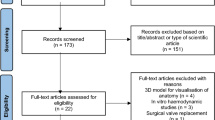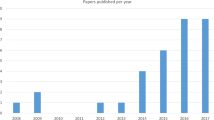Abstract
Purpose of Review
A combination of evolving 3D printing technologies, new 3D printable materials, and multi-disciplinary collaborations have made 3D printing applications for transcatheter aortic valve replacement (TAVR) a promising tool to promote innovation, increase procedural success, and provide a compelling educational tool. This review synthesizes the knowledge via publications and our group’s experience in this area that exemplify uses of 3D printing for TAVR.
Recent Findings
Patient-specific 3D-printed models have been used for TAVR pre-procedural device sizing, benchtop prediction of procedural complications, planning for valve-in-valve and bicuspid aortic valve procedures, and more. Recent publications also demonstrate how 3D printing can be used to test assumptions about why certain complications occur during THV implantation. Finally, new materials and combinations of existing materials are starting to bridge the large divide between current 3D material and cardiac tissue properties.
Summary
Several studies have demonstrated the utility of 3D printing in understanding challenges of TAVR. Innovative approaches to benchtop testing and multi-material printing have brought us closer to being able to predict how a THV will interact with a specific patient’s aortic anatomy. This work to date is likely to open the door for advancements in other areas of structural heart disease, such as interventions involving the mitral valve, tricuspid valve, and left atrial appendage.





Similar content being viewed by others
Abbreviations
- NOCD:
-
New onset conduction disturbance
- TAVR:
-
Transcatheter aortic valve replacement
- PPI:
-
Permanent pacemaker implantation
- BAV:
-
Balloon valvuloplasty
- LVOT:
-
Left ventricular outflow tract
- PVL:
-
Paravalvular leak
- TAVI:
-
Transcatheter aortic valve implantation
- AS:
-
Aortic stenosis
- 3DP:
-
Three-dimensional printing
- CT:
-
Computed tomography
- MRI:
-
Magnetic resonance imaging
- 3D TEE:
-
Three-dimensional transesophageal echocardiography
- 3D TTE:
-
Three-dimensional transthoracic echocardiography
- THV:
-
Transcatheter heart valves
- DICOM:
-
Digital imaging and communication in medicine
- SAVR:
-
Surgical aortic valve replacement
- BASILICA:
-
Intentional laceration to prevent iatrogenic coronary artery obstruction
References
Papers of particular interest, published recently, have been highlighted as: • Of importance •• Of major importance
Wang DD, Gheewala N, Shah R, Levin D, Myers E, Rollet M, et al. Three-dimensional printing for planning of structural heart interventions. Interv Cardiol Clin. 2018;7(3):415–23.
Giannopoulos AA, Steigner ML, George E, Barile M, Hunsaker AR, Rybicki FJ, et al. Cardiothoracic applications of 3-dimensional printing. J Thorac Imaging. 2016;31(5):253–72.
Bramlet M, Olivieri L, Farooqi K, Ripley B, Coakley M. Impact of three-dimensional printing on the study and treatment of congenital heart disease. Circ Res. 2017;120(6).
Vukicevic M, Mosadegh B, Min JK, Little SH. Cardiac 3D printing and its future directions. JACC Cardiovasc Imaging. 2017;10(2):171–84.
Farooqi KM, Sengupta PP. Echocardiography and three-dimensional printing: sound ideas to touch a heart. J Am Soc Echocardiogr. 2015;28(4):398–403.
Himbert D, Vahanian A. Transcatheter aortic valve replacement for patients with heart failure. Heart Fail Clin. 2015;11(2):231–42.
Thourani VH, Kodali S, Makkar RR, Herrmann HC, Williams M, Babaliaros V, et al. Transcatheter aortic valve replacement versus surgical valve replacement in intermediate-risk patients: a propensity score analysis. Lancet. 2016;387(10034):2218–25.
Leon MB, Smith CR, Mack M, Miller DC, Moses JW, Svensson LG, et al. Transcatheter aortic-valve implantation for aortic stenosis in patients who cannot undergo surgery. N Engl J Med. 2010;363(17):1597–607.
Smith CR, Leon MB, Mack MJ, Miller DC, Moses JW, Svensson LG, et al. Transcatheter versus surgical aortic-valve replacement in high-risk patients. N Engl J Med. 2011;364(23):2187–98.
Popma JJ, Deeb GM, Yakubov SJ, Mumtaz M, Gada H, O’Hair D, et al. Transcatheter aortic-valve replacement with a self-expanding valve in low-risk patients. N Engl J Med. 2019;380(18):1706–15.
Alkhouli M, Sengupta PP. 3-dimensional–printed models for TAVR planning. JACC Cardiovasc Imaging. 2017;10(7):732–4.
Achenbach S, Delgado V, Hausleiter J, Schoenhagen P, Min JK, Leipsic J. a. SCCT expert consensus document on computed tomography imaging before transcatheter aortic valve implantation (TAVI)/transcatheter aortic valve replacement (TAVR). J Cardiovasc Comput Tomogr. 2012;6(6):366–80.
Kasel AM, Cassese S, Bleiziffer S, Amaki M, Hahn RT, Kastrati A, et al. Standardized imaging for aortic annular sizing: implications for transcatheter valve selection. JACC Cardiovasc Imaging. 2013;6(2):249–62.
• Faletti R, Gatti M, Cosentino A, Bergamasco L, Cura Stura E, Garabello D, et al. 3D printing of the aortic annulus based on cardiovascular computed tomography: Preliminary experience in pre-procedural planning for aortic valve sizing. J Cardiovasc Comput Tomogr. 2018;12(5):391–397. In this original research paper, the authors 3D printed the aortic roots of 20 patients from CT data. They then compared measurements of 3D-printed aortic valve size to gold standard CT annular measurements and surgical valve sizing via Hegar dilators. No significant difference was found between intra-operative and 3D model measurements, thus verifying accuracy of the models for pre-surgical planning in this study.
Ripley B, Kelil T, Cheezum MK, Goncalves A, Di Carli MF, Rybicki FJ, et al. 3D printing based on cardiac CT assists anatomic visualization prior to transcatheter aortic valve replacement. J Cardiovasc Comput Tomogr. 2016;10(1):28–36.
Bompotis G, Meletidou M, Karakanas A, Sotiriou S, Sachpekidis V, Konstantinidou M, et al. Transcatheter aortic valve implantation using 3-D printing modeling assistance. A single-center experience. Hell J Cardiol. 2019;1.
Hosny A, Dilley JD, Kelil T, Mathur M, Dean MN, Weaver JC, et al. Pre-procedural fit-testing of TAVR valves using parametric modeling and 3D printing. J Cardiovasc Comput Tomogr. 2018; 2:1–0.
Schmauss D, Schmitz C, Bigdeli AK, Weber S, Gerber N, Beiras-Fernandez A, et al. Three-dimensional printing of models for preoperative planning and simulation of transcatheter valve replacement. Ann Thorac Surg. 2012;93(2):e31–3.
Fujita B, Kütting M, Seiffert M, Scholtz S, Egron S, Prashovikj E, et al. Calcium distribution patterns of the aortic valve as a risk factor for the need of permanent pacemaker implantation after transcatheter aortic valve implantation. Eur Heart J Cardiovasc Imaging. 2016;17(12):1385–93.
Tanaka Y, Saito S, Sasuga S, Takahashi A, Aoyama Y, Obama K, et al. Quantitative assessment of paravalvular leakage after transcatheter aortic valve replacement using a patient-specific pulsatile flow model. Int J Cardiol. 2018;258:313–20.
•• Qian Z, Wang K, Liu S, Zhou X, Rajagopal V, Meduri C, et al. Quantitative prediction of paravalvular leak in transcatheter aortic valve replacement based on tissue-mimicking 3D printing. JACC Cardiovasc Imaging. 2017;10(7):719–31 Building on Wang K et al (ref 38), the authors use a multimaterial 3D printing technique to create models that include hard calcifications and a meta-material meant to reproduce the stress-strain characteristics of aortic tissue. These models were CT scanned before and after benchtop deployment of a self-expanding stent to measure relative displacement of radiodense beads placed on the model surface. From this data, the authors propose a new assessment called the “bulge index” to predict which patients are at risk for paravalvular leak.
Hatoum H, Dollery J, Lilly SM, Crestanello JA, Dasi LP. Sinus hemodynamics variation with tilted transcatheter aortic valve deployments. Ann Biomed Eng. 2019;47(1):75–84.
Yamawaki M, Obama K, Sasuga S, Takahashi A, Ito Y, Umezu M, et al. Underfilled balloon-expandable transcatheter aortic valve implantation with ad hoc post-dilation ― pulsatile flow simulation using a patient-specific three-dimensional printing model ―. Circ J. 2019;83(2):461–70.
Dvir D, Webb JG, Bleiziffer S, Pasic M, Waksman R, Kodali S, et al. Transcatheter aortic valve implantation in failed bioprosthetic surgical valves. JAMA. 2014;312(2):162–70.
Dvir D, Webb J, Brecker S, Bleiziffer S, Hildick-Smith D, Colombo A, et al. Transcatheter aortic valve replacement for degenerative bioprosthetic surgical valves. Circulation. 2012;126(19):2335–44.
Allen KB, Chhatriwalla AK, Cohen DJ, Saxon JT, Aggarwal S, Hart A, et al. Bioprosthetic valve fracture to facilitate transcatheter valve-in-valve implantation. In: Annals of Thoracic Surgery. 2017.
Chhatriwalla AK, Allen KB, Saxon JT, Cohen DJ, Aggarwal S, Hart AJ, et al. Bioprosthetic valve fracture improves the hemodynamic results of valve-in-valve transcatheter aortic valve replacement. Circ Cardiovasc Interv. 2017;1:10(7).
Iung B, Vahanian A. Coronary obstruction: a rare but devastating complication during transcatheter aortic valve-in-valve implantation. Eur Heart J. 2018;39(8):696–8.
Dvir D, Webb JG, Piazza N, Blanke P, Barbanti M, Bleiziffer S, et al. Multicenter evaluation of transcatheter aortic valve replacement using either SAPIEN XT or CoreValve: degree of device oversizing by computed-tomography and clinical outcomes. Catheter Cardiovasc Interv. 2015;00(January):n/a-n/a.
Dvir D, Khan J, Kornowski R, Komatsu I, Chatriwalla A, Mackenson GB, et al. Novel strategies in aortic valve-in-valve therapy including bioprosthetic valve fracture and BASILICA. EuroIntervention. 2018;14(AB):AB74–82.
Komatsu I, Mackensen GB, Aldea GS, Reisman M, Dvir D. Bioprosthetic or native aortic scallop intentional laceration to prevent iatrogenic coronary artery obstruction. Part 1: how to evaluate patients for BASILICA. EuroIntervention. 2019;15(1):47–54.
Khan A, Gilani S, Dharmashankar K, Jaffery Z, Rangasetty UC, Fujise K. Percutaneous coronary intervention after transcatheter aortic valve replacement: approach and challenges. J Am Coll Cardiol. 2016.
Yoon SH, Lefèvre T, Ahn JM, Perlman GY, Dvir D, Latib A, et al. Transcatheter aortic valve replacement with early- and new-generation devices in bicuspid aortic valve stenosis. J Am Coll Cardiol. 2016.
Sievers HH, Schmidtke C. A classification system for the bicuspid aortic valve from 304 surgical specimens. J Thorac Cardiovasc Surg. 2007.
Jilaihawi H, Chen M, Webb J, Himbert D, Ruiz CE, Rodés-Cabau J, et al. A bicuspid aortic valve imaging classification for the TAVR era. JACC Cardiovasc Imaging. 2016.
Tchetche D, de Biase C, van Gils L, Parma R, Ochala A, Lefevre T, et al. Bicuspid aortic valve anatomy and relationship with devices: the BAVARD multicenter registry. Circ Cardiovasc Interv. 2019;12(1):e007107.
• Wang K, Zhao Y, Chang Y-H, Qian Z, Zhang C, Wang B, et al. Controlling the mechanical behavior of dual-material 3D printed meta-materials for patient-specific tissue-mimicking phantoms. Mater Des. 2016;90:704–12 This paper is the first description of a method for using sinusoidal elements and double helix structures printed out of high shore value material within flexible 3D printable material to mimic the stress-strain characteristics of arterial tissue.
Maragiannis D, Jackson MS, Igo SR, Schutt RC, Connell P, Grande-Allen J, et al. Replicating patient-specific severe aortic valve stenosis with functional 3D modeling. Circ Cardiovasc Imaging. 2015;8(10):1–8.
Acknowledgments
The authors thank Vivian Hou and Carol Hagen for help with photographing 3D models for figures.
Author information
Authors and Affiliations
Corresponding author
Ethics declarations
Conflict of Interest
Dmitry Levin, G. Burkhard Mackensen, Mark Reisman, James McCabe, Danny Dvir, and Beth Ripley declare that they have no conflict of interest.
Human and Animal Rights and Informed Consent
All procedures performed in studies involving human participants by the authors were in accordance with the ethical standards of the institutional and/or national research committee (University of Washington Human Subjects Division + HSD Study # STUDY00003286) and with the 1964 Helsinki Declaration and its later amendments or comparable ethical standards.
Additional information
Publisher’s Note
Springer Nature remains neutral with regard to jurisdictional claims in published maps and institutional affiliations.
This article is part of the Topical Collection on Cardiac PET, CT, and MRI
Rights and permissions
About this article
Cite this article
Levin, D., Mackensen, G.B., Reisman, M. et al. 3D Printing Applications for Transcatheter Aortic Valve Replacement. Curr Cardiol Rep 22, 23 (2020). https://doi.org/10.1007/s11886-020-1276-8
Published:
DOI: https://doi.org/10.1007/s11886-020-1276-8




